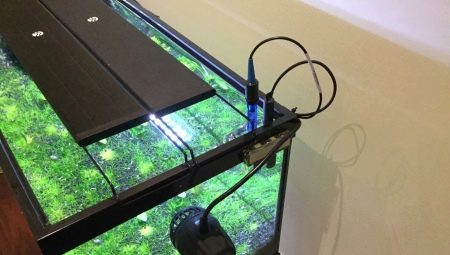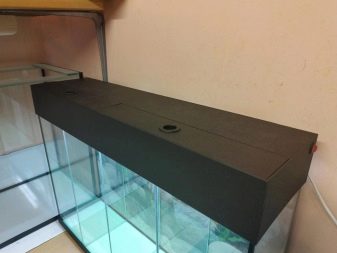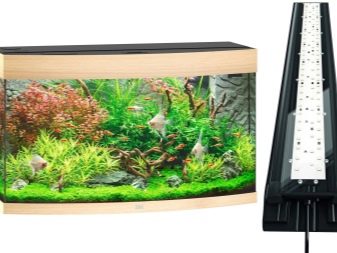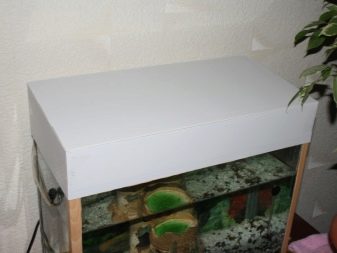How to make a do-it-yourself aquarium cover?

Typically, aquarium lids are purchased immediately when you buy a tank from a store. However, sometimes the required designs are not available, or the classic models are not suitable for containers of non-standard shapes or sizes. In this case, it makes sense to make the item yourself.


What is it for?
In fact, the aquarium cover serves several important functions that affect the life of underwater inhabitants. By closing the reservoir, the rate of evaporation of the water can be reduced. Otherwise, the amount of filling liquid will be unstable all the time, and the amount of oxygen will decrease significantly. As a result, the volume of fish waste will begin to increase, which will negatively affect their health, up to a fatal outcome.
Besides, the aquarium cover, of course, protects the aquarium itself from dust, dirt and other objects that could harm the inhabitants.

For some fish, one of the main values of the lid is its ability to prevent them from jumping out of the container. Without this obstacle, in most cases, they die immediately.
Prevents this part of the structure and the reverse threat - the ingress of paws and muzzles of pets inside the container. Finally, the lid also helps to maintain the required temperature inside the aquarium. Since some fish cannot even tolerate vibrations of a few degrees, this function is very important. In principle, it is customary to fix lamps, sometimes filters, an aerator or a device for automatic feed supply, on the roof.


Pros and cons of a homemade lid
Homemade lids have a number of advantages and disadvantages. If we talk about the pros, then the main thing, of course, is the ability to equip a non-standard structure, for example, the original form. In addition, the standard parts are equipped with only a pair of light bulbs, which in most cases turns out to be insufficient for underwater inhabitants. Since poor lighting leads to discomfort and nervousness in fish, as well as slowing down the development of plants, this situation is best avoided.

Factory parts are often made from several components, so when cleaning an aquarium or changing water, they must be completely disassembled.
Besides, finished covers do not imply a ventilation system, and the available places for pipes and wires are not wide enough, which complicates the care processes. It can also be mentioned that the factory part is always installed low, which leads not only to its overheating, but also to the release of condensation. Naturally, all of the above explains the popularity of hand-made designs.
The disadvantages of self-made covers can be attributed only to the effort and time that will have to be spent on developing the perfect model.

Materials and tools for manufacturing
A homemade aquarium cover can be made from a variety of materials, not limited to the standard glass model. They are all financially affordable and sold at regular home improvement stores.

Plastic
In most cases, PVC panels, plastic, laminate, plexiglass and plywood become the basis. Plastic lids are most often sold in stores, but at home, plastic can be used to create a structure.
Such material is inexpensive and is quite easily and quickly processed, despite the chosen shape and size of the tank.
In addition, the plastic object itself looks quite dignified, but in addition it can be pasted over with self-adhesive paper and create an individual design that fits perfectly into the existing interior. The disadvantages of homemade plastic parts include seams. Since the material is not fixed with a sealant, you still have to use glue, and over time, it begins to release moisture.


Laminate
Used to create lids and regular laminate flooring. It is quite easy to assemble a lid from it, but the finished structure can turn out to be very heavy and inconvenient to use. Since the material itself has an impressive weight, the situation will be critical if a cover is created for a two-hundred-liter aquarium. Since the lid must be removed and put back on a regular basis, everything can end up falling and breaking the tank itself.
In addition, a laminate structure is made using metal fittings, which, as a result of close interaction with water, will soon be covered with rust.

The damaged parts will have to be changed or regularly processed with special compounds, which means spending extra money and making additional efforts. It is impossible not to mention that low quality laminate is not durable. The coating does not lend itself well to transformation, which means that it is not possible to cover the lid with a film and make its appearance more aesthetic.

Pvc
Homemade PVC aquarium covers are quite popular. The foam material is lightweight, easy to use, but quite dense and tough. White panels can be easily painted or decorated with a special foil.


Moreover, colored PVC panels are also on sale. Fixation of individual elements is carried out with a special adhesive.
Nevertheless, it is rather difficult to call the material environmentally friendly and non-toxic, therefore some opponents of this material consider it dangerous for underwater inhabitants. In addition, over time, it fades, and mechanical stress reveals the fragility of PVC.

Plexiglass
Plexiglass is a good choice for aquarium cover... This material is much lighter than ordinary glass and looks much more aesthetically pleasing than the same laminate or plastic. Unfortunately, it is difficult to process, so it is only suitable for skilled craftsmen.
Important! Plywood is sometimes used for this purpose, but it serves very little. As the material is quickly exposed to liquid, it dries up and loses its usefulness.


Fittings
Besides the main material, you will definitely need accessories - corners made of the appropriate material. Everything is fastened, as a rule, with a pistol filled with silicone sealant. In addition, it is reasonable to prepare self-adhesive paper or acrylic paint, gloves, knife, gloves, stationery from the tools.
Since lighting fixtures are fixed on the cover, it makes sense to immediately prepare light bulbs with wires.



It is worth mentioning right away that experts do not recommend using PVA or superglue as an adhesive. If it is decided to fix the filter, cooler or fan directly on the lid, then suitable models must be selected at the stage of preparation.
How to make?
Making an aquarium cover with your own hands follows the same general scheme, regardless of the material chosen. First, the sidewalls are assembled, then the upper part, after which all the parts are fixed to each other.
At the final stage, the lighting is carried out in such a way that its repair in the future is not particularly difficult. Of course, even before the manufacture of the structure, measurements are carried out. For example, if PVC is chosen as the main material, then the plates are laid out on the floor, right on them you have to measure the height and width of the future cover.
Further, individual parts are cut out, and gradual assembly begins. The sides are glued to the base, and you can proceed to attaching the inner corners.

A part is fixed at each corner of the box-like structure, and it is necessary to retreat slightly from the upper edge of the structure. In addition, stiffeners are placed vertically from the inside of the sidewalls.
All gluing points are treated with a sealant.
It is immediately necessary to make cuts for the wires, existing hoses and filling the feed. For greater aesthetics, the finished structure can be pasted over with acrylic paint or self-adhesive. Before using the coloring material, you can first prime the surface, and glue the lid with foil from the inside. At each stage of the assembly, experts recommend first degreasing the elements, then trying them on, and then fixing them with an adhesive. The finished lid should be left to ventilate overnight.



Setting the backlight
Since well-organized lighting is one of the important functions of a homemade cover, you will also have to make the backlight yourself... The number of lamps is determined depending on the required volume of light. It also depends on the volume of the reservoir and on the needs of its inhabitants. For example, for an aquarium with a volume of 140 liters, it is preferable to use several LED and energy saving lights. In the manufacture of the lid, the cartridges for them will immediately come in handy.
Making the backlight will require basic knowledge of an electrician, so if you don't have it, it's better to contact a knowledgeable person.

The wires are connected to each other and insulated, after which they should be fixed in metal holders located at the required height. Small pieces of plastic are glued to the base of the cover to serve as a substrate for the lamp holders. By placing all the details on the lid, it is important to ensure that they never reach the liquid level. The bulbs themselves are fixed with self-tapping screws, which usually come with them in the kit.
Of course, the electrical wires must be brought out. It is important to remember that with a lack of lighting, aquarium plants begin to die, and the fish themselves feel much worse, so this aspect of keeping the aquarium should not be ignored... It is better to buy lamps for the tank in pet stores.
How to make a cover for an aquarium with your own hands, see below.








